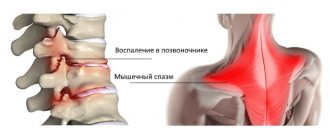Pharmacological properties
Pharmacodynamics.
Lornoxicam, an NSAID with analgesic and anti-inflammatory properties, belongs to the oxicam class. The mechanism of action of lornoxicam is mainly associated with inhibition of prostaglandin synthesis (inhibition of the COX enzyme), which leads to desensitization of peripheral nociceptors and inhibition of inflammation. a central effect on nociceptors is also suggested, which is not associated with anti-inflammatory effects. Lornoxicam does not affect vital signs (for example, body temperature, respiratory rate, heart rate, blood pressure, ECG, spirometry). The analgesic properties of lornoxicam were successfully demonstrated in several clinical studies during the development of the drug. Due to local gastrointestinal irritation and systemic ulcerogenic effects associated with inhibition of prostaglandin (PG) synthesis, the use of lornoxicam and other NSAIDs often leads to the development of gastrointestinal complications.
Pharmacokinetics. Absorption. Lornoxicam is quickly and almost completely absorbed from the gastrointestinal tract. Cmax is achieved 1–2 hours after taking the drug. The bioavailability of lornoxicam is 90–100%. No first pass effect was noted. The average half-life is 3–4 hours.
When co-administering lornoxicam with food, Cmax is reduced by approximately 30% and Tmax is increased from 1.5 to 2.3 hours. Absorption of lornoxicam (calculated according to the area under the concentration/time pharmacokinetic curve (AUC)) may be reduced by up to 20%.
Lornoxicam 8 mg powder for injection is intended for intravenous and intramuscular administration. Cmax in blood plasma after intramuscular administration of the drug is achieved after 0.4 hours. Bioavailability (calculated by AUC) after intramuscular administration of the drug is 97%.
Distribution. In blood plasma, lornoxicam is unchanged and in the inactive form of its hydroxylated metabolite. The binding of lornoxicam to plasma proteins is 99% and does not depend on its concentration.
Biotransformation. Lornoxicam is extensively metabolized in the liver by hydroxylation, initially to the inactive 5-hydroxylornoxicam. Lornoxicam undergoes biotransformation with the participation of cytochrome CYP 2C9. The metabolism of this enzyme due to genetic polymorphism may be slow or intense in different individuals, which may lead to a marked increase in plasma levels of lornoxicam in individuals with poor metabolism. The hydroxylated metabolite has no pharmacological activity. Lornoxicam is completely metabolized. Approximately ⅔ is excreted through the liver and 1/3 through the kidneys as an inactive compound.
In animal model studies, lornoxicam did not induce liver enzymes. Based on the results of clinical studies, there is no evidence of accumulation of lornoxicam after repeated administration in recommended doses. These results were confirmed by data from monitoring the safety and effectiveness of drugs for 1 year of the study.
Excretion. Half-life of the original substance is 3–4 hours. After oral administration, about 50% is excreted in the feces and 42% through the kidneys, mainly in the form of 5-hydroxylornoxicam. T½ of 5-hydroxylornoxicam is about 9 hours after parenteral administration of the drug 1 or 2 times a day.
In elderly patients (over 65 years of age), clearance is reduced by 30–40%. Apart from decreased clearance, there are no significant changes in the kinetic profile of lornoxicam in the elderly.
There is no significant change in the kinetic profile of lornoxicam in patients with renal or hepatic impairment, with the exception of accumulation in persons with chronic liver disease, after 7 days of therapy using daily doses of 12 and 16 mg.
Release form
White oblong tablets (dosage 4 mg) with engraved inscription “LO4“.
- 10 pieces in a blister - 10, 1, 2, 3 or 5 blisters in a pack of paper.
White oblong tablets (dosage 8 mg) with the engraved inscription “LO8“.
- 10 pieces in a blister - 10, 1, 2, 3 or 5 blisters in a pack of paper.
The lyophilisate for making the solution is a dense yellow mass.
- 5 glass bottles in a paper pack.
- 5 glass bottles in a plastic tray; 1 pallet in a pack of paper.
Application
Pills
For all patients, the appropriate dosage regimen should be based on individual response to treatment.
Pain
The dose of lornoxicam is 8–16 mg/day, divided into 2–3 doses. The maximum recommended daily dose is 16 mg.
Osteoarthritis and rheumatoid arthritis
An initial dose of 12 mg of lornoxicam, divided into 2-3 doses, is recommended. The maintenance dose should not exceed 16 mg/day.
Xefocam film-coated tablets are taken orally with a sufficient amount of water.
Elderly patients (over 65 years of age), except for those with impaired liver or kidney function: no dose adjustment is required, but lornoxicam should be used with caution due to the likelihood of adverse reactions from the gastrointestinal tract.
Kidney failure. For patients with mild to moderate renal impairment, the maximum recommended daily dose is 12 mg, divided into 2-3 doses.
Liver failure. For patients with moderate hepatic impairment, the maximum recommended daily dose is 12 mg, divided into 2-3 doses (see SPECIAL INSTRUCTIONS).
Adverse reactions can be minimized by taking the drug at the lowest effective dose and for the shortest period necessary to control symptoms (see SPECIAL INSTRUCTIONS).
Injections
This dosage form of the drug is intended to initiate therapy and to quickly achieve an analgesic effect or in case it is impossible to use oral medications or suppositories. For all patients, the appropriate dosage regimen should be based on individual response to treatment.
For intravenous and intramuscular administration.
The recommended dose is 8 mg IV or IM. Some patients require an additional dose of 8 mg in the first 24 hours. The maximum daily dose is 16 mg.
The duration of intravenous administration of the solution should be at least 15 s, intramuscularly - at least 5 s. After preparing the solution, the needle should be replaced.
For intramuscular injection, a long needle is required, which ensures deep insertion. The medicine is intended for one-time use only. Prepare solution for injection immediately before use (the contents of 1 bottle (8 mg of lyophilisate) are dissolved with water for injection (2 ml)).
Elderly patients (over 65 years of age), except for those with impaired liver or kidney function, dosage adjustment is not required, but lornoxicam should be used with caution due to the likelihood of adverse reactions from the gastrointestinal tract.
Kidney failure. Patients with mild to moderate renal failure require a dose reduction.
Liver failure. Patients with moderate hepatic impairment require a dose reduction.
Adverse reactions can be minimized by taking the drug at the lowest effective dose and for the shortest period necessary to control symptoms (see SPECIAL INSTRUCTIONS).
Reconstituted solution: The chemical and physical stability of the reconstituted solution has been demonstrated for 24 hours at 2–8°C. From a microbiological point of view, the drug should be used immediately. In case of non-use immediately, the period and conditions of storage of the reconstituted solution before its use are the responsibility of the user.
When is Xefocam indicated: instructions
Among the indications for taking the medication: pain of various origins, subject to the action of non-steroidal analgesics. Including those caused by:
- rheumatoid arthritis;
- deforming arthrosis;
- gout;
- ankylosing spondylitis.
The medication effectively reduces pain to moderate and moderate-to-severe intensity. Xefocam does not affect the general course of diseases; it is used only for symptomatic therapy: in short courses.
The drug is used with caution for pathologies of the gastrointestinal tract, smoking, alcoholism, heart failure, and diabetes.
Contraindications
- Hypersensitivity to lornoxicam or other components of the drug; thrombocytopenia; hypersensitivity (symptoms similar to those of asthma, rhinitis, angioedema or urticaria) to other NSAIDs, including acetylsalicylic acid; severe form of heart failure; gastrointestinal bleeding, cerebrovascular or other bleeding; a history of gastrointestinal bleeding or ulcer perforation associated with previous NSAID therapy; active recurrent peptic ulcer/bleeding or history of recurrent peptic ulcer/bleeding (2 or more separate proven episodes of ulceration or bleeding); severe form of liver failure; severe form of renal failure (plasma creatinine level 700 µmol/l); iii trimester of pregnancy (see use during pregnancy and lactation).
Side effects
Most often, adverse reactions to NSAIDs were associated with the gastrointestinal tract. When using NSAIDs, peptic ulcers, perforation or gastrointestinal bleeding may occur, which is sometimes fatal, especially in the elderly (see special instructions). nausea, vomiting, diarrhea, flatulence, constipation, dyspepsia, abdominal pain, melena, hematemesis, ulcerative stomatitis, exacerbation of colitis and Crohn's disease have been reported with NSAID treatment. Gastritis occurred less frequently.
It is estimated that ≈20% of patients treated with lornoxicam may experience adverse events. The most common side effects of lornoxicam are nausea, dyspepsia, indigestion, abdominal pain, vomiting, and diarrhea. These symptoms overall were observed in 10% of patients in the study. Edema, hypertension and heart failure have been reported with NSAID treatment.
Clinical studies and epidemiological data indicate that the use of some NSAIDs, especially in high doses and over long periods of time, may be associated with an increased risk of arterial thrombotic events such as myocardial infarction or stroke (see WARNINGS).
Serious infectious complications of the skin and soft tissues have been reported exclusively during the course of chickenpox.
Adverse effects according to the frequency of occurrence are classified into the following categories: very often (≥1/10); often (≥1/100, 1/10); uncommon (≥1/1000, 1/100); rare (≥1/10,000, 1/1000); very rare (1/10,000), unknown (frequency cannot be estimated from available data).
Infections and infestations: rarely - pharyngitis.
From the blood and lymphatic system: rarely - anemia, thrombocytopenia, leukopenia, increased duration of bleeding; very rarely - ecchymosis. NSAIDs can cause class-specific, potentially severe hematological disorders, such as neutropenia, agranulocytosis, aplastic anemia, hemolytic anemia.
From the immune system: rarely - hypersensitivity reactions, anaphylactoid reactions and anaphylaxis.
Metabolic disorders: uncommon - loss of appetite, changes in body weight.
Mental disorders: infrequently - insomnia, depression; rarely - anxiety, nervousness, excitement.
From the nervous system: often - mild and transient headache, dizziness; rarely - drowsiness, paresthesia, taste disturbances (dysgeusia), tremor, migraine; very rarely - aseptic meningitis in patients with systemic lupus erythematosus and mixed connective tissue disease (see SPECIAL INSTRUCTIONS).
From the organ of vision: infrequently - conjunctivitis; rarely - visual impairment.
On the part of the organ of hearing and balance: infrequently - vertigo, tinnitus.
From the cardiovascular system: infrequently - palpitations, tachycardia, edema, heart failure, facial flushing; rarely - hypertension, hot flashes, hemorrhages, hematomas.
From the respiratory system: infrequently - rhinitis; rarely - dyspnea, cough, bronchospasm.
From the digestive system: often - nausea, abdominal pain, dyspepsia, diarrhea, vomiting; uncommon - constipation, flatulence, belching, dry mouth, gastritis, stomach ulcer, abdominal pain, abdominal pain in the upper abdomen, duodenal ulcer, ulcers of the oral mucosa; rarely - melena, vomiting with blood, stomatitis, esophagitis, gastroesophageal reflux, dysphagia, aphthous stomatitis, glossitis, ulcer perforation, gastrointestinal bleeding.
From the liver and biliary tract: infrequently - increased levels of liver enzymes (ALAT, AST); very rarely - toxic effects on the liver, which may result in the development of liver failure, hepatitis, jaundice, cholestasis.
From the skin and subcutaneous tissues: infrequently - rash, itching, increased sweating, erythematous rash, urticaria, angioedema, alopecia; rarely - dermatitis, eczema, purpura; very rarely - swelling and bullous reactions, such as erythema multiforme, Stevens-Johnson syndrome, toxic epidermal necrolysis.
From the musculoskeletal system and connective tissue: infrequently - arthralgia; rarely - a feeling of pain in the bones, muscle spasms, myalgia.
From the kidneys and urinary tract: rarely - nocturia, difficulty urinating, increased levels of urea nitrogen and creatinine in the blood; very rarely, lornoxicam may cause acute renal failure in persons with kidney disease, which is dependent on renal prostaglandins, which have an important role in maintaining renal blood flow (see PRECAUTIONS). Nephrotoxicity in various forms, including nephritis and nephrotic syndrome, is a class-specific effect of NSAIDs.
General disorders: infrequently - malaise, swelling of the face; rarely - asthenia.
Composition and pharmaceutical form
The active substance of the drug is lornoxicam, which belongs to the group of non-steroidal anti-inflammatory drugs. The drug has a pronounced analgesic effect without affecting the thermoregulation centers and the cardiovascular system.
Xefocam is produced in the form of a lyophilized powder, soluble in water. The light yellow dense mass is packaged in dark glass bottles. One dose of the drug contains 8 mg of lornoxicam and stabilizing additives, including mannitol, trometamol. When combined with a liquid, the drug is converted into a homogeneous colored solution.
The injections are intended for parenteral administration: intravenously and intramuscularly. One cardboard package of Xefocam contains 5 bottles of lyophilized dry mass.
special instructions
For the following disorders, the drug can be prescribed only after a thorough assessment of the ratio of the expected benefit of therapy/possible risk.
Lornoxicam should be used with caution in patients with mild renal impairment (serum creatinine levels 150–300 μmol/L) and moderate renal impairment (serum creatinine levels 300–700 μmol/L) due to the important role of prostaglandins in maintaining renal blood flow. If renal function deteriorates, treatment with the drug should be discontinued.
People who have had major surgery, have heart failure, or are taking diuretics or medications that can cause kidney damage should have their kidney function closely monitored.
In patients with bleeding disorders, a thorough clinical examination and evaluation of laboratory parameters (eg activated partial thrombin time) are recommended.
Persons with liver failure (for example, cirrhosis of the liver) after using the drug at a dose of 12-16 mg / day are recommended to regularly conduct laboratory tests due to the possibility of accumulation of lornoxicam in the body (increased AUC). But no deviations in pharmacokinetic parameters were detected in patients with liver failure compared to healthy volunteers.
During long-term treatment (3 months), it is recommended to assess blood status (hemoglobin determination), kidney function (creatinine determination) and liver enzymes.
Elderly people (over 65 years of age) are advised to monitor kidney and liver function and use the drug with caution after surgery.
The combined use of lornoxicam with other NSAIDs, including selective COX-2 inhibitors, should be avoided.
Adverse reactions can be minimized by taking the lowest effective dose of the drug for the short period necessary to control symptoms of the disease.
When using any NSAID at any time during treatment, gastrointestinal bleeding, ulceration or perforation may occur (with or without warning symptoms or a history of serious gastrointestinal disorders), which can be fatal.
The risk of gastrointestinal bleeding, ulceration or perforation increases with increasing doses of NSAIDs in patients with a history of ulcers, especially those complicated by bleeding or perforation (see CONTRAINDICATIONS), as well as in the elderly. These groups of patients should be especially careful when starting treatment with the drug at the lowest therapeutic doses.
NSAIDs should be used with caution to treat the above groups of patients and persons concurrently taking acetylsalicylic acid in low doses or other drugs that increase the risk of gastrointestinal complications (see INTERACTIONS). For patients requiring such combination therapy, treatment can be carried out while taking protective agents (eg misoprostol or proton pump inhibitors). Clinical follow-up at regular intervals is recommended.
Patients with a history of GI toxicity, especially the elderly, should report any unusual abdominal symptoms (especially GI bleeding) during the initial stages of treatment. Use extreme caution in patients concomitantly using medications that may increase the risk of ulceration or bleeding, such as oral corticosteroids, anticoagulants such as warfarin, selective serotonin reuptake inhibitors, or antithrombotic drugs such as acetylsalicylic acid (see INTERACTIONS).
If bleeding or gastrointestinal ulceration occurs in patients taking lornoxicam, treatment should be discontinued.
NSAIDs should be used with caution in patients with a history of gastrointestinal diseases (ulcerative colitis, Crohn's disease), as their condition may worsen. In elderly people, the incidence of adverse reactions when using NSAIDs increases, in particular gastrointestinal bleeding and perforation, which can be fatal (see CONTRAINDICATIONS). The drug should be used with caution in patients with hypertension and/or a history of heart failure, since edema and fluid retention in the body may occur as a result of taking NSAIDs.
Patients with a history of hypertension and/or congestive heart failure of mild to moderate severity should be monitored, since NSAID therapy may be accompanied by phenomena such as fluid retention and edema. There are clinical studies and epidemiological data that suggest that the use of some NSAIDs (especially long-term therapy and at high doses) may be associated with a small increased risk of arterial thrombotic events (eg myocardial infarction or stroke). There is insufficient data to exclude such a risk with lornoxicam.
In patients with uncontrolled hypertension, chronic heart failure, coronary artery disease, peripheral arterial disease and/or cerebrovascular disease, lornoxicam should be prescribed only after careful evaluation of the indications. Evaluation is also required before initiating long-term treatment in individuals with cardiovascular risk factors (eg, hypertension, hyperlipidemia, diabetes mellitus, smoking). Combination treatment with NSAIDs and heparin increases the risk of spinal/epidural hematoma during spinal or epidural anesthesia (see INTERACTIONS).
Very rarely, skin reactions occur with the use of NSAIDs, including exfoliative dermatitis, Stevens-Johnson syndrome and toxic epidermal necrolysis, sometimes some of them are fatal (see SIDE EFFECTS). The risk of developing such reactions is highest at the beginning of treatment: in most cases, such reactions occur in the 1st month of taking the drug. Lornoxicam should be discontinued at the first sign of skin rash, mucosal lesions, and other manifestations of hypersensitivity.
Use with caution in persons with asthma or a history of this disease, since NSAIDs provoke bronchospasm in these patients.
Patients with systemic lupus erythematosus and mixed connective tissue disease may have an increased risk of developing aseptic meningitis.
Lornoxicam inhibits platelet aggregation, increasing blood clotting time.
The drug should be prescribed with caution to patients with a tendency to bleeding.
Concomitant treatment with NSAIDs and tacrolimus may increase the risk of nephrotoxicity due to decreased renal prostacyclin synthesis. Renal function must be carefully monitored during this combination therapy.
Like other NSAIDs, lornoxicam may cause episodic increases in transaminases, serum bilirubin, as well as increases in blood urea and creatinine concentrations, as well as other laboratory abnormalities. If the deviations in laboratory parameters are significant and continue for a long time, treatment must be stopped and the necessary research carried out.
The drug contains lactose. Patients with rare hereditary galactose intolerance, lactase deficiency or glucose-galactose malabsorption should not use the drug.
Lornoxicam, like other drugs that suppress COX/prostaglandin synthesis, can reduce fertility and is therefore not recommended for use in women planning pregnancy. Women who have problems becoming pregnant or who are undergoing evaluation for infertility should stop taking lornoxicam.
In the presence of chickenpox, in exceptional cases, severe infectious lesions of the skin and soft tissues may develop. By this time, the influence of NSAIDs on the worsening of these infectious diseases cannot be ruled out. It is recommended to avoid the use of lornoxicam if you have chickenpox.
Use during pregnancy or breastfeeding. Pregnancy. Lornoxicam is contraindicated in the third trimester of pregnancy. There are no clinical data on the use of lornoxicam in the first and second trimesters of pregnancy and during childbirth, so the drug is not recommended for use during this period.
There is insufficient data regarding the use of lornoxicam in pregnant women. Animal studies have shown reproductive toxicity.
Suppression of prostaglandin synthesis may adversely affect pregnancy and/or embryonic/fetal development. Data from epidemiological studies indicate an increased risk of miscarriage, as well as the development of heart defects when using prostaglandin synthesis inhibitors in early pregnancy. The risk increases with increasing dose and duration of therapy. In animals, the use of prostaglandin synthesis inhibitors leads to an increase in pre- and post-implantation fetal death and embryofetal mortality. Prostaglandin synthesis inhibitors should not be used in the first and second trimesters of pregnancy. Use is possible only when absolutely necessary.
In the third trimester of pregnancy, when using any prostaglandin synthesis inhibitors, the following effects on the fetus are possible:
- cardiopulmonary toxicity (premature closure of the ductus arteriosus and pulmonary hypertension);
- impaired renal function, which can progress to renal failure with the manifestation of oligohydroamnion.
The pregnant woman and the fetus at the end of pregnancy may be exposed to the following effects from the use of prostaglandin synthesis inhibitors:
- possible increase in the duration of bleeding;
- suppression of the contractile function of the uterus, which can lead to a delay or increase in the duration of labor.
Thus, the use of lornoxicam is contraindicated in the third trimester of pregnancy (see CONTRAINDICATIONS).
Breastfeeding period. There is no data on the excretion of lornoxicam into human breast milk. Relatively high concentrations of lornoxicam are excreted into the milk of lactating rats. Therefore, lornoxicam should not be used during breastfeeding.
Children. Lornoxicam is not recommended for use in children under 18 years of age due to the lack of clinical data on the effectiveness and safety of the drug.
The ability to influence reaction speed when driving vehicles or working with other mechanisms. If dizziness and/or drowsiness occurs as a result of taking lornoxicam, you should not drive vehicles or operate other machinery.
Interactions
Concomitant use of lornoxicam and the following drugs:
- cimetidine: increased plasma concentrations of lornoxicam (no interactions between lornoxicam and ranitidine or lornoxicam and antacids have been identified);
- Anticoagulants: NSAIDs may increase the severity of the effects of anticoagulants (for example, warfarin - see SPECIAL INSTRUCTIONS). MNI should be closely monitored;
- phenprocoumon: the effectiveness of treatment with phenprocoumon decreases;
- heparin: NSAIDs increase the risk of spinal/epidural hematoma when used concomitantly with heparin during spinal or epidural anesthesia (see WARNINGS);
- ACE inhibitors: may reduce the severity of the effect of ACE inhibitors;
- diuretics: weakening of the diuretic and hypotensive effect of loop, thiazide and potassium-sparing diuretics;
- β-adrenergic receptor blockers: weakening of the hypotensive effect;
- Angiotensin II receptor blockers: decreased hypotensive effect;
- Digoxin: decreased renal clearance of digoxin;
- corticosteroids: increased risk of gastrointestinal ulcers or bleeding (see WARNINGS);
- antibacterial agents of the quinolone group: increases the risk of seizures;
- antiplatelet drugs: increases the risk of gastrointestinal bleeding (see SPECIAL INSTRUCTIONS);
- other NSAIDs: increases the risk of gastrointestinal bleeding;
- methotrexate: an increase in the concentration of methotrexate in the blood plasma, which leads to an increase in its toxicity. Close monitoring is necessary during concurrent use;
- SSRIs: increases the risk of gastrointestinal bleeding (see SPECIAL INSTRUCTIONS);
- Lithium preparations: NSAIDs reduce the renal clearance of lithium, so serum lithium concentrations may exceed the toxicity threshold. It is necessary to monitor the level of lithium in the blood serum, especially at the beginning of treatment, when adjusting the dose and stopping treatment;
- cyclosporine: increased concentration of cyclosporine in the blood serum. Increased nephrotoxicity of cyclosporine is possible due to effects mediated by renal prostaglandins. During combination therapy, it is necessary to monitor renal function;
- sulfonylurea derivatives (for example glibenclamide): the risk of hypoglycemia will increase;
- known inducers and inhibitors of CYP 2C9 isoenzymes: lornoxicam (like other NSAIDs dependent on cytochrome P450 2C9 (CYP 2C9 isoenzyme)) interacts with known inducers and inhibitors of CYP 2C9 isoenzymes (see Biotransformation);
- tacrolimus: increased risk of nephrotoxicity due to decreased renal prostacyclin synthesis. During combination therapy, it is necessary to monitor renal function (see SPECIAL INSTRUCTIONS);
- pemetrexed: NSAIDs may decrease the renal clearance of pemetrexed, resulting in increased renal and gastrointestinal toxicity and myelosuppression.
Since food slows down the absorption of lornoxicam, Xefocam tablets should not be taken with food if a rapid onset of effective action (pain relief) is required.
Eating reduces absorption by ≈20% and increases Tmax.
Incompatibility. The drug in the form of an injection solution should not be mixed with other drugs, except those specified in the instructions for use.
Overdose
Currently, there is no data regarding overdose that would allow us to determine its consequences or suggest specific treatment. As a result of an overdose of lornoxicam, the following symptoms may occur: nausea, vomiting, cerebral symptoms (dizziness, blurred vision). in severe cases: ataxia, with transition to coma and convulsions; liver and kidney damage; Possible blood clotting disorder. in case of real or suspected overdose, use of the drug should be discontinued. Thanks to the short half-life, lornoxicam is quickly eliminated from the body. dialysis is ineffective. There is currently no specific antidote. The usual emergency measures, including gastric lavage, should be carried out. Based on general principles, only the use of activated carbon when taken immediately after an overdose of lornoxicam can lead to a decrease in absorption of the drug. For the treatment of gastrointestinal disorders, you can, for example, use a prostaglandin analogue or ranitidine.
Analogues of Xefocam
Level 4 ATX code matches:
Mirlox
Revmoxicam
Xefocam Rapid
Movalis
Mesipol
Lem
Melbek
Movasin
Piroxicam
Lornoxicam
Arthrozan
Texamen
Amelotex
Meloxicam
Zornica, Xefocam Rapid, Larfix, Lorakam, Aroxicam, Aspicam, Loxidol, Melbek, Meloxicam, Revmalim, Rekoxa.
The price of Xefocam analogues, which are listed above, is in almost all cases higher than the price of Xefokam itself.
Note!
Description of the drug Xefocam por. d/r-well d/in. 8mg vial. No. 5 on this page is a simplified author’s version of the apteka911 website, created on the basis of the instructions for use.
Before purchasing or using the drug, you should consult your doctor and read the manufacturer's original instructions (attached to each package of the drug). Information about the drug is provided for informational purposes only and should not be used as a guide to self-medication. Only a doctor can decide to prescribe the drug, as well as determine the dose and methods of its use.
Xefocam price, where to buy
The price of Xefocam in tablets of 8 mg No. 10 in Russia is 150-200 rubles. For comparison, the price of an ampoule with lyophilisate is approximately 160 rubles, 5 ampoules - 750 rubles.
Buying Xefocam 8 mg No. 10 in Ukraine will cost an average of 80-105 hryvnia, and the price of Xefocam No. 5 injections reaches 410 hryvnia.
- Online pharmacies in RussiaRussia
- Online pharmacies in UkraineUkraine
- Online pharmacies in KazakhstanKazakhstan
ZdravCity
- Xefocam Rapid tablets p.p.o.
8 mg 12 pcs. Takeda Pharma A/S RUB 351 order - Xefocam tablets p.p.o. 8 mg 30 pcs. Takeda GmbH
RUB 487 order
- Xefocam tablets p.p.o. 8 mg 10 pcs. Takeda GmbH
RUB 235 order
- Xefocam liof. d/prig. solution for intravenous and intramuscular injection. 8mg vial. No.5Wasserburger Arzneumittelwerk GmbH
RUR 783 order
Pharmacy Dialogue
- Xefocam Rapid (tab.p.pl/vol.8mg No. 12)Takeda
RUB 338 order
- Xefocam (tab.p.pl/vol.8mg No. 30)Takeda
516 RUR order
- Xefocam (vial 8 mg No. 5)Wasserburger
770 rub. order
- Xefocam (tablet p/o 8 mg No. 10)Takeda
RUB 242 order
show more
Pharmacy24
- Xefocam Rapid 8 mg No. 6 tablets Takeda GmbH, manufacturing plant Oranienburg, Germany/Takeda Pharma A/S, Denmark
93 UAH.order - Xefocam 8 mg No. 10 tablets Nycomed Austria GmbH.Austria/Nycomed Austria GmbH.Austria,Nimecchina/Takeda GmbH,Nimecchina
94 UAH order
- Xefocam 4 mg N10 tablets Takeda GmbH, city of Vir-va Oranienburg, Germany
59 UAH order
- Xefocam 8 mg No. 5 lyophilisate Nycomed Austria GmbH.Austria/Takeda Austria GmbH,Austria
446 UAH. order
PaniPharmacy
- Xefocam tablets Xefokam tablets. p/o 8 mg No. 10 Germany, Takeda
110 UAH order
- Xefocam rapid tablets Xefocam rapid tablets p/o 8 mg No. 6 Denmark, Takeda Pharma
98 UAH order
- Ksefokam bottle Ksefokam por. d/in. 8ml fl. No.5 Austria, Takeda Austria
481 UAH order
- Xefocam tablets Xefokam tablets. p/o 4 mg No. 10 Germany, Takeda
75 UAH order
show more







